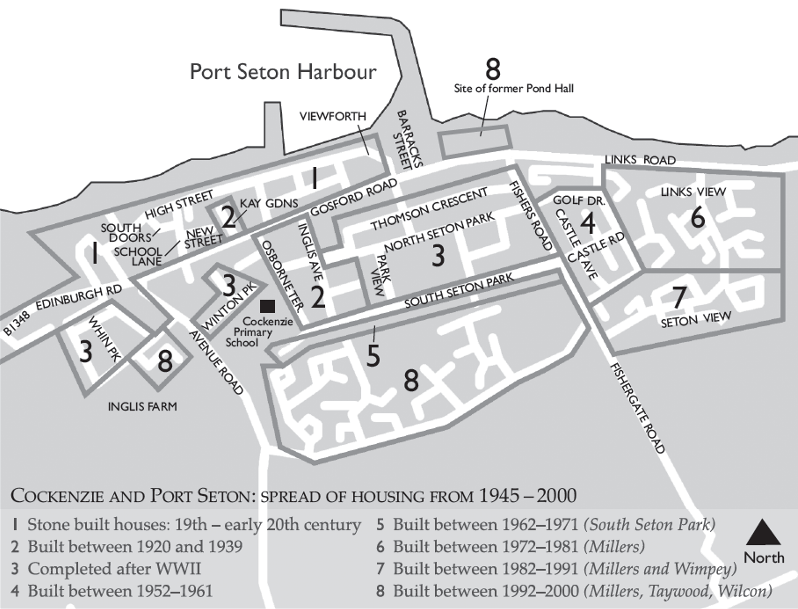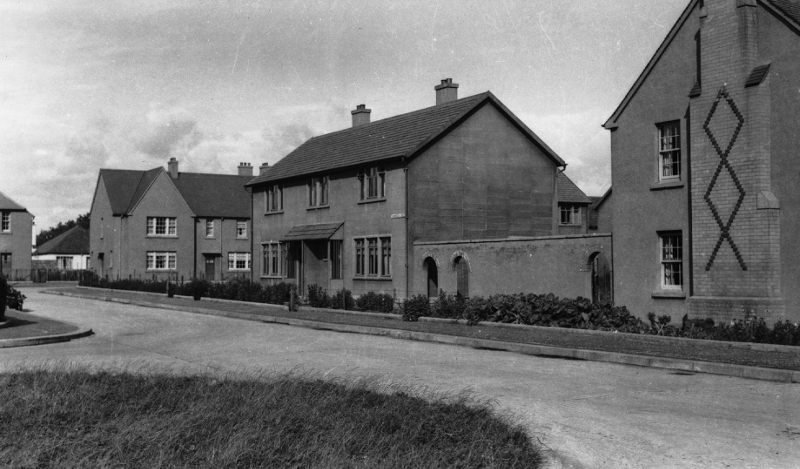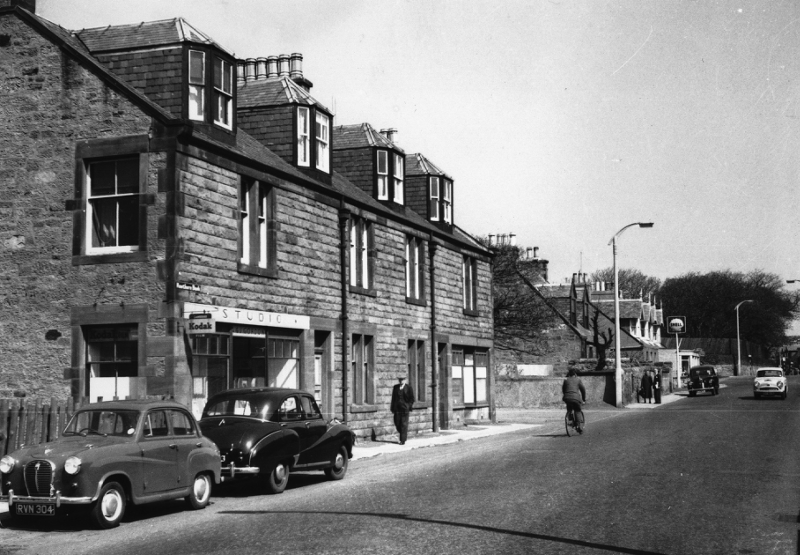Homes | Changes & Conversions | In Port Seton | Shops & Services
There was only one settlement – that of Cockenzie & Port Seton – in this area between 1945 and 2000. From 1945-1970s the majority of people in Port Seton lived in accommodation rented from the local council. Privately owned property was mainly around Gosford Road, Edinburgh Road and Viewforth overlooking the harbour. From the 1970s onward privately owned housing expanded rapidly eastward and southward of the village. Home ownership increased even more during the 1980s under the right to buy legislation and by the end of the period approximately 75% of council housing was under private ownership.
By 2000, the types of housing in Cockenzie and Port Seton consisted mainly of the following:
stone-built, single and two-storey terraced cottages; two-storey detached cottages; two- and three-storey flats; two-storey terraced houses (both council and privately owned); single terraced houses (privately owned and council owned for the elderly) and two-storey detached houses (as opposed to cottages).
Existing pre-war housing fell roughly into two areas: the older area of Cockenzie with its stone built cottages, located mainly on the north side of Edinburgh Road, and another area west of the village green also contained traditional stone built terraced cottages.

Map showing spread of housing in Cockenzie and Port Seton from 1945 – 2000
On the south side of Edinburgh Road were the houses built by the town council between 1920 and 1939. Areas such as Kay Gardens, Inglis Avenue and Osborne Terrace were built at this time; houses on the north side of South Seton Park that had been started before the war were completed.
From the 1950s to 1961, house building by the local council continued with houses being built on the land east of Fishers Road, comprising Castle Road, Castle Avenue and so on. As well as new areas around the village being allocated for council housing, areas within the village were being re-developed; in Cockenzie High Street a block of six flats for the elderly were built and at Barracks Street flats were built and named Bayview.
Over the next decade, council house building continued with houses being built on the south side of South Seton Park, beginning at Fishers Road and continuing westwards as far as Osborne Terrace. Phase 1 was built in 1965 for key workers from Cockenzie Power Station.

Houses in Golf Drive off Fishers Road (A&J Gordon)
Meanwhile the village was still expanding eastwards with the development of private housing. The period 1972 – 81 saw the development of private housing east of Fishers Road continued with houses built by Miller Homes at Links View, comprising maisonette type houses and single storey terraced houses. Between 1982 and 1991, private house building continued east of Fishers Road, where houses and flats were built by Wimpey. Miller Homes also built houses in Seton Wynd and View. Inglis Farm was also developed in this decade.

Houses in Thomson Crescent. Corner house on right is on North Seton Park (A&J Gordon)
The final decade of the period saw private housing being built on land south of South Seton Park. Approximately 800 homes were to be built between Millers, Taywood and Wilcon.
Changes & Conversions
A big change over time occurred in Cockenzie High Street; from the early 1970s onwards, shops were gradually closing down and the property reverted back to family accommodation. By 2000 only two shops remained. There were a number of buildings that, by the end of the period, had been converted to homes of one sort or another.
Most of the changes occurred in Cockenzie.
In School Lane, Cockenzie the building that was the original Chalmers Memorial Church (1855) and then the church hall was bought in 1957 and used as a storage shed for potatoes. This was demolished in 1999 to make way for flats, the builder being Rollo & Sons, a local builder.
The Bethel in New Street, Cockenzie (built in 1889) – the place of worship for the fishing community – was converted into a house in 1993, as was another Bethel in South Doors in 1992.
The area in Cockenzie opposite South Lorimer Place, once the site of a pig farm, was cleared for private housing in 1994. The estate was named Inglis Farm and consists of 20, two-storey, detached houses built to the owners’ specifications.
In Port Seton
The most controversial housing was that built where the Pond Hall stood. This was a combination of hall and swimming pool built in the 1930s. Demolition of the Pond Hall scheduled for 1995 provoked public outcry and efforts were made by the public to save it, but to no avail. Two-storey terraced housing and a day centre for the elderly were built on the site in 1998 by Hart Ltd.
There were two non-family homes in the burgh:
Cockenzie House (see also Townscapes, Buildings and Landscapes of Distinction) is a large, four-storey house set in its own grounds at the west end of the village. Once the home of the Cadell family it was opened in 1986 as a home for the elderly. At 31 Edinburgh Road, a two-storey detached house was used as family accommodation until 1994 when it was bought for the accommodation of people with learning difficulties.
Shops & Services
The shops & services on offer in Cockenzie High Street changed beyond recognition. In the period 1945 – 51 there were four butchers shops, a Co-operative, a chemists, two licensed grocers, a bakery, a barbers, a babywear shop, an electrical shop, and a post office. The area was a thriving community quite independent of Port Seton. However, by the early 1970s there was a marked decline of retail business in the area, as this had shifted to the Port Seton end of the village and High Street shops were being shut down and reverting back to houses, being mostly bought by young first-time buyers. By the mid 1990s the post office was shut down and converted to a house leaving only the baker’s shop, the Thorntree Inn and a Chinese take-away in Cockenzie High Street.

High Street, Cockenzie, early 1940s, looking east towards Port Seton harbour. The shop on the right is the Co-op (note the Chemist’s symbol above the door). Next door is a baker’s shop, with a sign above the door saying ‘Public Telephone’.

High Street, Cockenzie c1960, looking west. The shop on the right is Peter Harkess’ butcher’s at No 96, next door to the Thorntree Inn which is just out of the picture.
The following overview sums up the changes in Cockenzie & Port Seton over the period:
| 1953 | 1990 | 2000 | |
|---|---|---|---|
| Grocers/general | 7 | 2 | 3 |
| Butchers | 4 | 2 | 1 |
| Drapers | 4 | 1 | – |
| Bakers | 3 | 1 | 1 |
| Bakehouse | 1 | 1 | 1 |
| Greengrocers | 2 | 1 | Seton Mains Farm |
| Newsagents | 2 | 2 | 1 |
| Hardware | 1 | 1 | Ships Chandler |
| Boots & shoes | 1 | – | – |
| Chemists | 1 | 1 | 1 |
| Electrical appliances | 1 | 1 | – |
| Fish shops | – | 2 | 3 |
| Fish & chip shops | 5 | 1 | 1 |
| Chinese carryout | – | 2 | 3 |
| Restaurant/café | 2 | 2 | 2 |
| Hotel/pubs | 3 | 4 | 3 |
| Hairdressers/barbers | 3 | 5 | 5 |
| Fancy goods | – | 1 | 1 |
| Charity shop | – | – | 1 |
The decline of the fishing trade within the parish certainly changed the face of the retail and business community. The demand for food and other supplies to be used on board fishing trips had declined considerably. Cockenzie & Port Seton was always a dormitory settlement, supplying manpower to the industries in the surrounding area. At one time, manpower was provided for the coalmines, now all closed; the engineering firms and businesses, and latterly to the power station in Prestonpans. The village still retained its own character, in spite of being almost a suburb of Edinburgh.
An increasing portion of the population commuted to work, which meant that the ‘shopping’ was done elsewhere. The tendency was to use large supermarkets where practically everything was available under one roof, resulting in less support for the local shops.
The earliest years of the second half of the 20th century still saw the travelling shop and the door-to-door salesman bringing commodities to your doorstep. The man selling brushes, polish and pot menders, another with clothes, and the ‘wee boys’ trousers’ man. Vegetables arrived on the horse and cart and of course the ‘Onion Johnny’ – the onion sellers from the continent, who sold long strings of onions from their pedal cycles – also called. The Co-operative van, with groceries and bakery goods, was a regular visitor.
Several businesses have come and gone since the 1950s. There was a small industrial estate between Cockenzie Harbour and Marshall Street; unfortunately the businesses are no longer, and the area awaits development, as does the boatyard at Cockenzie West Harbour and several fish curing establishments. Three motor repair garages and an office/industrial cleaning firm continue to thrive close by.

High Street Cockenzie, looking west, 1970s, with Cockenzie Power Station beyond. Brown’s Licensed Grocer’s on the left has obviously changed hands, as the window contains electrical goods.

A&J Gordon’s photographic studio, Hawthorn Bank, Edinburgh Road, Cockenzie (A&J Gordon)
The village still has a few shops left including the faithful Co-op. The main shop was on Edinburgh Road, with the fruit shop and the bakehouse in School Lane, and the ‘wee store’ in Wemyss Place. These have all been converted into private housing. The Co-op has just one building in Links Road with a chemist shop included, and is still the centre for the daily/weekly chat. We can still enjoy fresh fish from a local fishmonger. It would not be Port Seton if this were taken away from us. Fresh bread is available from the bakers and the Co-op, fruit and vegetables from the Co-op and at Seton Mains Farm Shop at the south end of Fishergate Road.
Daily newspapers and milk are still delivered to your door. The Royal Bank of Scotland has now closed their branch in Port Seton; this was done some years ago not without a great deal of protest from the residents. A cashline machine was installed at the Co-op building, another case of inanimate response rather than an animate one. The post office, which was located in the High Street, has now been absorbed into the Spar retail shop on Gosford Road, so the pensions can be collected, bills paid and post sent. The old post office building was sold and is now a private house.
Hopefully the decline in shops and businesses within the parish has ended. We all require to purchase goods locally on occasion. We must remember that they are a very necessary part of the community.